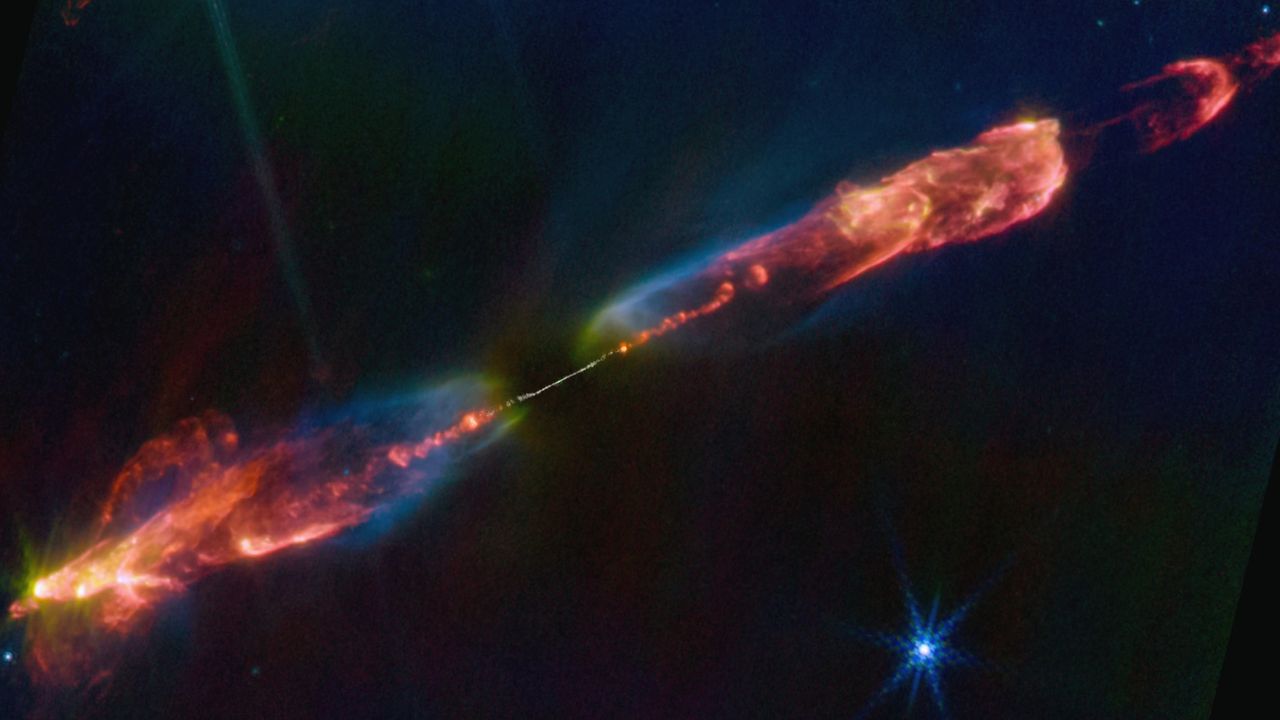Science
ALMA and JWST Uncover Secrets of Star Formation in Perseus

A groundbreaking study has unveiled significant insights into the star formation process, focusing on a young star system known as HH 211, located approximately 1,000 light-years from Earth in the constellation Perseus. This research, published in the journal Scientific Reports on August 13, 2023, utilized data from the Atacama Large Millimeter/submillimeter Array (ALMA) in Chile and the James Webb Space Telescope (JWST) to explore the dynamics of protostellar jets, which play a crucial role in star development.
HH 211 is classified as a Herbig-Haro object—a luminous area formed by energetic jets emitted from newborn stars. At just 35,000 years old, this protostellar system hosts a central protostar with a mass only 0.06 times that of the Sun. The system exhibits a striking bipolar jet, where two beams of ionized material shoot outward in opposite directions, revealing the complex interplay between magnetic fields and star formation.
The research team discovered that the jets from HH 211 travel at speeds reaching around 66 miles per second (or 107 kilometers per second). Despite this rapid movement, the jets rotate slowly, indicating that they are effective in carrying away excess rotational energy from the star’s accretion disk. This finding aligns with existing models suggesting that magnetic fields can assist in launching material away from the star, thereby facilitating its growth.
While jets are typically challenging to observe due to their proximity to the star, the ALMA data provided a unique glimpse into their origins. The study determined that the jets originate from the inner edge of the accretion disk, situated merely 0.02 astronomical units—approximately 1.85 million miles (or 3 million kilometers)—from the protostar itself. This revelation marks the first time researchers have successfully identified the launch site of a protostellar jet.
The ALMA observations were complemented by imaging from the JWST, which captured the vibrant displays of the jets in near-infrared wavelengths. However, the dense cosmic dust surrounding the central region obscured some details critical to understanding the jet’s origins. The integration of ALMA’s submillimeter data with JWST’s infrared images allowed researchers to construct a comprehensive picture of the star formation process.
The collaboration between these two powerful telescopes not only highlights the sophistication of modern astronomical techniques but also emphasizes the significance of protostellar jets in star development. As these jets help regulate the angular momentum within the accretion disk, they enable the smooth infall of material, thereby promoting the growth of new stars.
This research adds valuable knowledge to the ongoing exploration of star formation, which remains one of the most fundamental yet enigmatic processes in the universe. The findings from HH 211 could pave the way for further investigations into how stars are born, ultimately enhancing our understanding of the cosmos.
-

 Politics1 week ago
Politics1 week agoDallin H. Oaks Assumes Leadership of Latter-day Saints Church
-

 Sports1 week ago
Sports1 week agoSteve Kerr Supports Jonathan Kuminga After Ejection in Preseason Game
-

 Lifestyle1 week ago
Lifestyle1 week agoDua Lipa Celebrates Passing GCSE Spanish During World Tour
-

 Business1 week ago
Business1 week agoTyler Technologies Set to Reveal Q3 2025 Earnings on October 22
-

 Entertainment1 week ago
Entertainment1 week agoZoe Saldana Advocates for James Cameron’s Avatar Documentary
-

 Science1 week ago
Science1 week agoChicago’s Viral ‘Rat Hole’ Likely Created by Squirrel, Study Reveals
-

 Lifestyle1 week ago
Lifestyle1 week agoKelsea Ballerini Launches ‘Burn the Baggage’ Candle with Ranger Station
-

 Health1 week ago
Health1 week agoRichard Feldman Urges Ban on Menthol in Cigarettes and Vapes
-

 Health1 week ago
Health1 week agoCommunity Unites for Seventh Annual Mental Health Awareness Walk
-

 World1 week ago
World1 week agoD’Angelo, Iconic R&B Singer, Dies at 51 After Cancer Battle
-

 Business1 week ago
Business1 week agoMega Millions Jackpot Reaches $600 Million Ahead of Drawings
-

 Business1 week ago
Business1 week agoMLB Qualifying Offer Jumps to $22.02 Million for 2024









